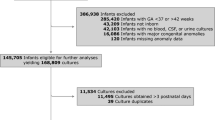Abstract
BACKGROUND:
In Florida during the period 1992 through 1994, there was a major drop in the length of stay for full-term, singleton, vaginally delivered newborn babies in the hospital. A major concern on the part of clinicians has been the potential of an increased risk of sepsis (manifesting itself after discharge) associated with earlier newborn discharge from the hospital. We used the Florida hospital discharge dataset to study the frequency of readmission with sepsis after early newborn discharge to home.
METHODS:
Using the Florida Agency for Health-Care Administration Acute Care Hospital Discharge Dataset, we used a multivariate, probabilistic matching algorithm to merge newborn discharge records for births from 1992 through 1994 with readmission discharge records (including hospital-to-hospital transfers and multiple readmissions) during the first 28 days of life. We used the resulting merged dataset to study bacterial infection diagnoses on newborn and readmission records and to examine relationships between readmission diagnoses and timing of newborn discharge among the 364,528 full-term, singleton, vaginally delivered babies (FTSVDBs) without congenital anomalies from 1992 through 1994 in Florida acute-care hospitals.
RESULTS:
Overall, 86.3% of all FTSVDBs born in Florida acute-care hospitals were discharged between day of life (DOL) 0 (born and discharged the same day) and DOL 2 (discharged two calendar days after birth). The group B streptococci (GBS) infection code was found on the newborn discharge records of 9.2 per 10,000 FTSVDBs over the 3-year period, 5.9% of which involved hospital-to-hospital transfer of the baby. Escherichia coli infection codes were found on the records of 3.4 per 10,000 FTSVDBs over the 3-year period, 2.3% of which involved hospital-to-hospital transfer of the baby. Of those FTSVDBs discharged to home without infection codes during DOL 1 to 2, 0.8 per 10,000 were readmitted within 7 days (inclusive) with GBS infection, and 2.0 per 10,000 with E. coli infection. When the data for readmitted babies were pooled for 1992 through 1994, the odds ratio for probability of readmission comparing discharges on DOL 1 to DOL 2 for GBS was 2.27 (95% confidence interval, 1.83 to 2.70), and for E. coli 2.16 (95% confidence interval, 1.46 to 2.85). Over this 3-year period, for babies discharged on DOL 1, there was a 115% increase in the rate of readmission for GBS from 1992 through 1994 (p < 0.01) and a 36.5% increase in the rate of readmission for E. coli (p < 0.05). However, among FTSVDBs discharged on DOL 2, the rate of readmission for both GBS and E. coli did not change during the period 1992 through 1994. There were no deaths among FTSVDBs as either newborns, transfers, or readmissions within 7 days of discharge, with either GBS or E. coli infection codes on their discharge record.
CONCLUSION:
From 1992 through 1994, the increased number of babies discharged early in Florida was temporally associated with an increased rate of readmission during the week after discharge for both GBS and E. coli infection among babies discharged on the calendar day after birth. With an increase in both the number of babies exposed to the risks of early discharge, and an increased rate of these serious infections during the week after discharge from the hospital, the number of these babies grew to exceed, by several fold, the number of babies with inborn errors of metabolism picked up by state screening programs.
This is a preview of subscription content, access via your institution
Access options
Subscribe to this journal
Receive 12 print issues and online access
$259.00 per year
only $21.58 per issue
Buy this article
- Purchase on Springer Link
- Instant access to full article PDF
Prices may be subject to local taxes which are calculated during checkout
Similar content being viewed by others
Author information
Authors and Affiliations
Rights and permissions
About this article
Cite this article
Graven, M., Cuddeback, J. & Wyble, L. Readmission for Group B Streptococci or Escherichia coli Infection among Full-Term, Singleton, Vaginally Delivered Neonates after Early Discharge from Florida Hospitals For Births from 1992 through 1994. J Perinatol 19, 19–25 (1999). https://doi.org/10.1038/sj.jp.7200099
Published:
Issue Date:
DOI: https://doi.org/10.1038/sj.jp.7200099
This article is cited by
-
Early discharge of term neonates: we can do it safely
Italian Journal of Pediatrics (2015)



